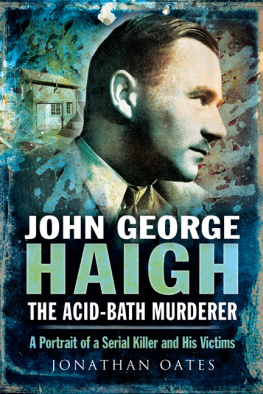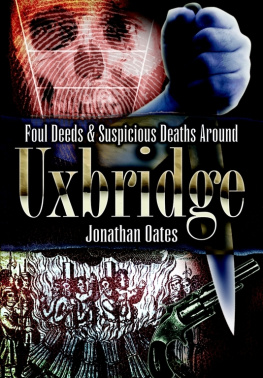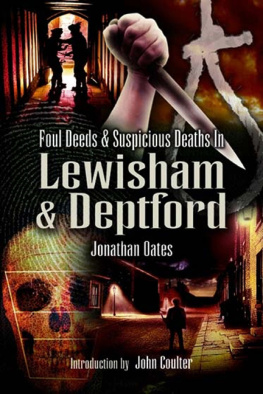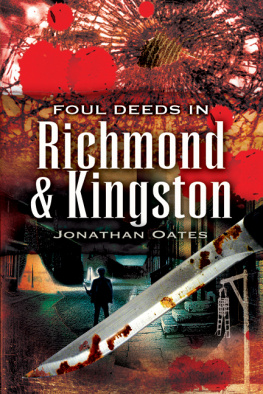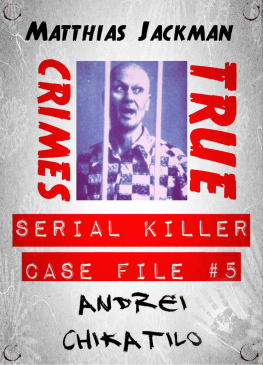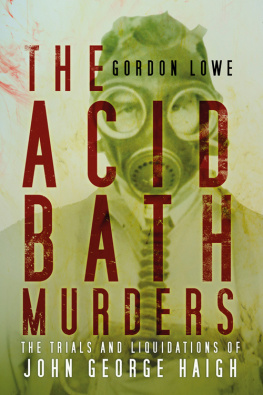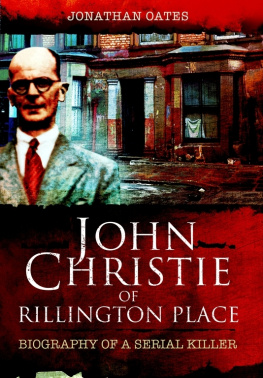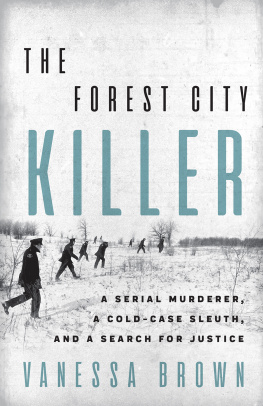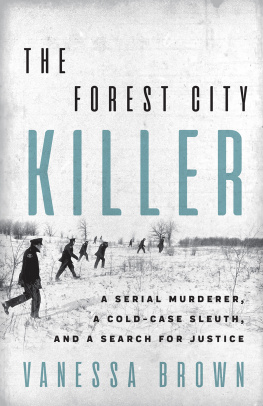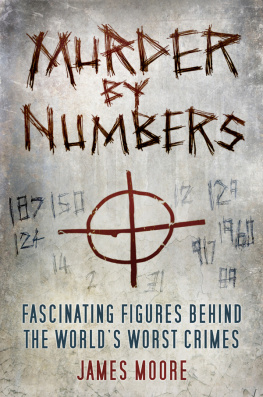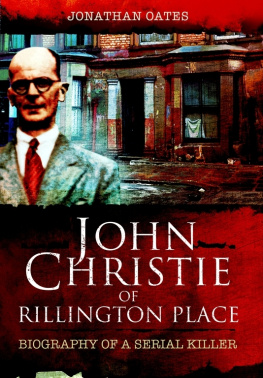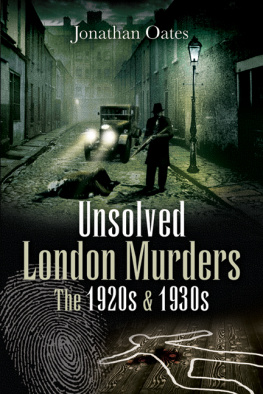First published in Great Britain in 2014 by
Pen & Sword True Crime
an imprint of
Pen & Sword Books Ltd
47 Church Street
Barnsley
South Yorkshire
S70 2AS
Copyright Jonathan Oates 2014
ISBN 978 1 78346 214 8 Hardback
978 1 47383 793 5 Paperback
eISBN 9781473841239
The right of Jonathan Oates to be identified as the Author of this Work has been asserted by him in accordance with the Copyright, Designs and Patents Act 1988.
A CIP catalogue record for this book is available from the British Library
All rights reserved. No part of this book may be reproduced or transmitted in any form or by any means, electronic or mechanical including photocopying, recording or by any information storage and retrieval system, without permission from the Publisher in writing.
Typeset in Ehrhardt by
Mac Style, Bridlington, East Yorkshire
Printed and bound in the UK by CPI Group (UK) Ltd, Croydon, CRO 4YY
Pen & Sword Books Ltd incorporates the imprints of Pen & Sword
Archaeology, Atlas, Aviation, Battleground, Discovery, Family
History, History, Maritime, Military, Naval, Politics, Railways, Select,
Transport, True Crime, and Fiction, Frontline Books, Leo Cooper,
Praetorian Press, Seaforth Publishing and Wharncliffe.
For a complete list of Pen & Sword titles please contact
PEN & SWORD BOOKS LIMITED
47 Church Street, Barnsley, South Yorkshire, S70 2AS, England
E-mail: enquiries@pen-and-sword.co.uk
Website: www.pen-and-sword.co.uk
Acknowledgements
M any people have kindly given of their time and knowledge in the preparation of this book. Firstly, my thanks to the staff at a number of institutions who have assisted with this book; at the National Archives, the British Library, the Institute of Criminology in Cambridge, Wakefield Archives, West Sussex Record Office, Leeds Local and Family History Library, Glasgow University Library, Glasgow High School, Wakefield Library and Stamford Library. Thanks also to Paul Lang for reading the text through and helping with postcard illustrations and to Stewart McLaughlin of Wandsworth Prison for giving a tour of the prison and for providing access to archival material there. I have also had useful exchanges with fellow authors David Briffett and Sean OConnor. Members of my family have accompanied me to many of the sites associated with Haigh (in Crawley, Horsham, Wakefield, Outwood, Stamford and what was the Onslow Court Hotel), as well as researching at Wakefield Library for me. Queen Elizabeth Grammar School in Wakefield were able to assist with a snippet of information about Haighs education. Thank you to Charlotte Burford, archivist at Madam Tussauds waxworks, for assisting with a photograph of a waxwork of Haigh and to Paul Bickley and Keith Skinner at Scotland Yards Crime Museum. Antony Davis provided information about the Haighs Outwood home. Martin Fido read the text and offered useful comments. The Mayors office for Policing and Crime allowed the use of the Crime Museum photograph.
This book is dedicated to my mother.
Introduction
When a clever man turns his brain to crime it is the worst of all .
Sherlock Holmes
J ohn George Haigh was charming, handsome, immaculately dressed, cultured and intelligent. A well-mannered and thoroughly nice man. He was also one of Britains most notorious serial killers of the twentieth century. This was partly because he was the most prolific British serial killer in the first half of that century, but also because of the alleged motive that he claimed had driven him to murder. Haigh said that the desire to drink his victims blood had been his reason for such slaughter he claimed that he was a vampire. Then there was the novel method of disposal of his victims corpses in acid that meant he was dubbed the Acid Bath Murderer. Finally, Haigh exhibited a glamour in his looks and lifestyle, like another of that decades murderers, Neville Heath (191746), which seemed to put him in a different sphere from the run-of-the-mill murderer. He was described as one of the most baffling criminals of this or any other age, and one of the most notorious murderers of this century. Such a figure would have been in the limelight in any era, but in the austerity years of post-World War Two Britain even more economically straitened than during the war Haigh appeared in even more dramatic hues.
This aura of disreputable glamour, but glamour nonetheless, still attaches itself to Haigh to an extent. The only celluloid interpretation of his murders, A is for Acid , broadcast in 2002, cast a popular actor as the killer and presented his life and crimes in as sympathetic a manner as possible. Unlike John Christie (1899-1953) in 10 Rillington Place , Haigh was seen as a human being, with attractive traits as well as moments of murderous violence. There have also been those who have attempted to portray him as a man suffering from mental illness and thus not accountable for his actions. It is true that he was not a sadist like Ian Brady and Myra Hindley, Peter Sutcliffe and Fred and Rosemary West; nor did he kill on the industrial scale of doctors such as John Bodkin Adams or Harold Shipman. There was no sexual dimension to his crimes, as with Christie, and no children were involved as in the Moors Murders.
Yet Haigh did kill six people, the same number or more than some of the centurys other serial killers. Each of these people should also be remembered. Usually, the narratives of Haighs case have downplayed the six and so put their humanity at a discount. Yet Donald and Amy McSwan and their son, William Donald McSwan, Dr Archibald Henderson and his wife, Rosalie, and Henrietta Helen Olivia Robarts Durand-Deacon were all personalities in their own right, as was Haigh himself.
There have been five full-length studies of Haigh, published between 1950 and 1988, of varying value, and several part studies. He has been portrayed variously as an enigmatic man of contrasts, a man scarred by his parents religion, or simply a calculating murderer. Haighs crimes regularly appear in books about famous criminals, London crime and serial killers; these synopses are usually rehashes of existing published work, rather than being based on original research. These have, like so many other accounts of well-known criminals, resulted in numerous myths being created and disseminated by successive works. This account will correct these and shed new light on Haigh and his victims.
To do this, we must draw on original, primary, sources. Some of these have not been available to previous writers. These include the Home Office, Prison Commission and Metropolitan Police files on the case, held at the National Archives at Kew. They also include the corpus of letters written by Haigh to his parents, mostly while in prison in 1949 and held at the Institute of Criminology at Cambridge, relevant court and prison archives, including papers held at the London Metropolitan Archives and the Crime Museum, as well as the more familiar transcripts of the trial and contemporary newspaper sources. Genealogical sources, such as census returns, civil registration records, wills, military records, parish and electoral registers have also been used to shed additional light on the characters involved. Where other books have been used, it has either been for the opinions therein or because they contain primary material available nowhere else.
It is worth noting that until 1949 Haigh was known to few others. He had appeared in local newspapers as a criminal on two occasions, but otherwise had generally left little imprint on local or national life. But for a few months in 1949, from the time of his arrest until his execution, he was a national and an international figure. Much the same can be said of those he killed. Most of what we know about Haigh, and his victims, originates from this year or thereafter, because it was only then that they became of interest to those outside their immediate circles. Most, though not all, of the information about these people, therefore, is thus coloured by their involvement in this case as murderer or as murder victims. How far this distorts the value of this evidence is a moot point. Likewise, the accuracy of memory can also be queried and this is of particular note when Haighs childhood and youth are recounted.

